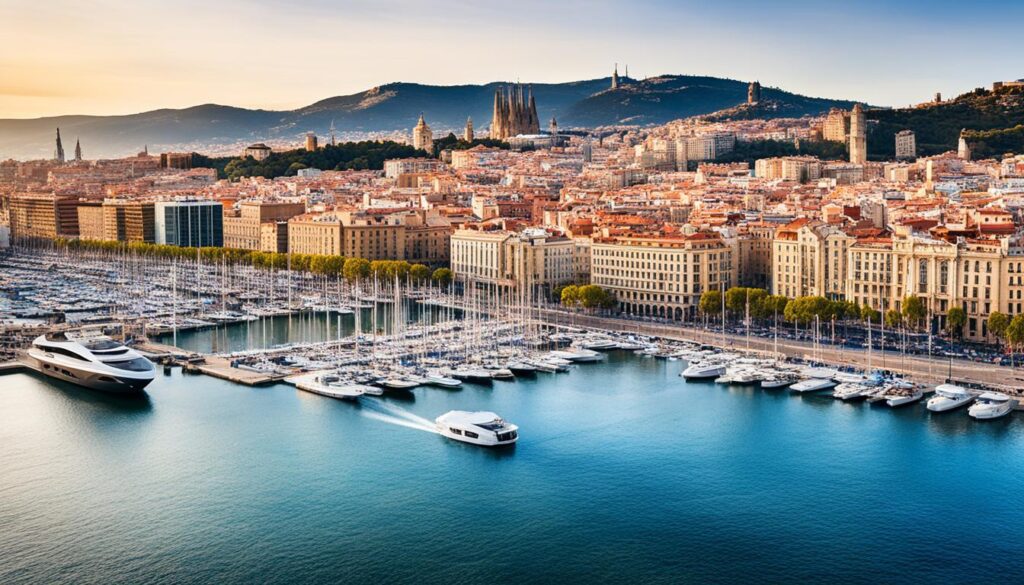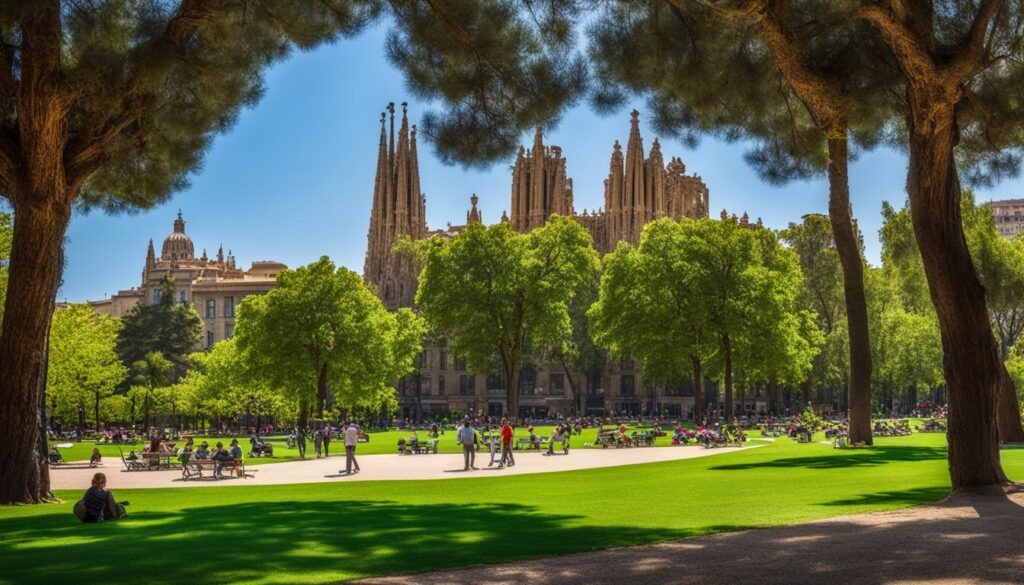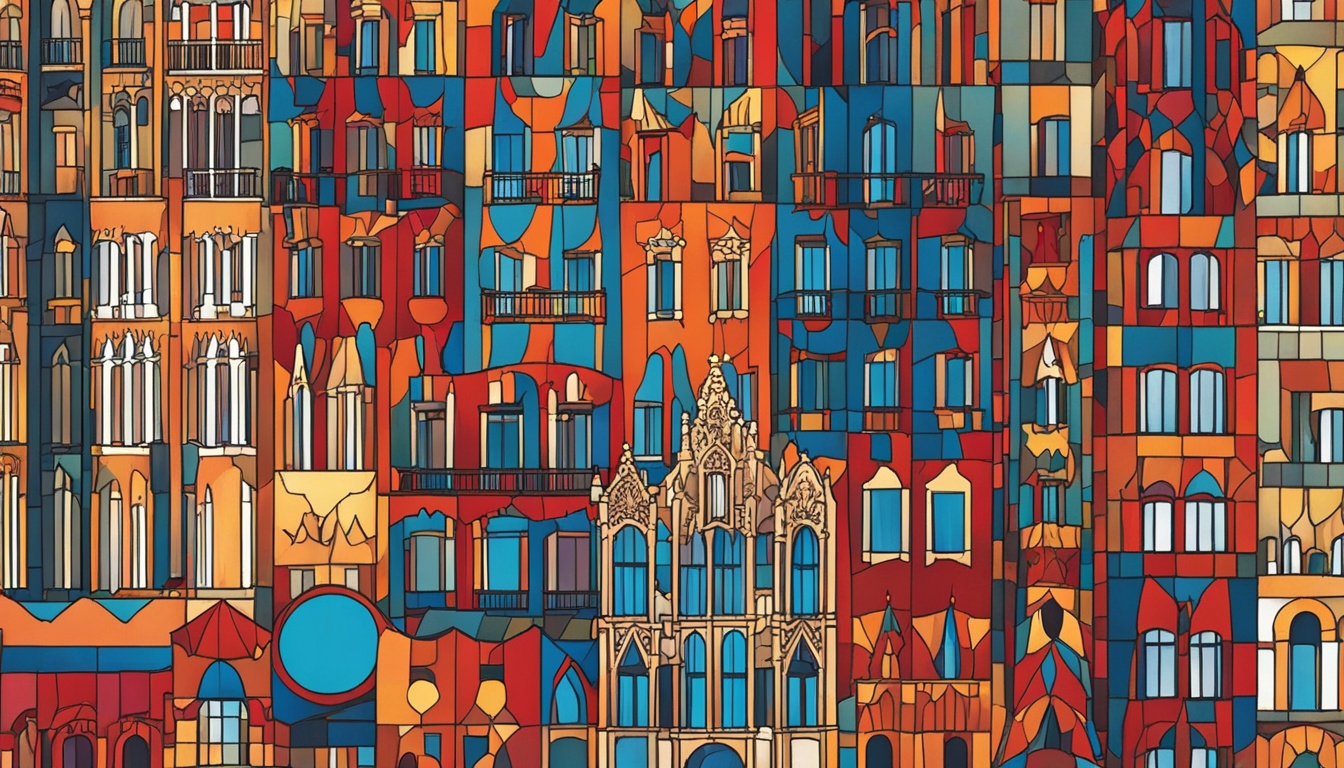Barcelona is a city on the northeastern coast of the Iberian Peninsula with a history over 2,000 years old. It sits at the crossroads of many civilizations, giving it a unique identity. This identity is seen in its art, culture, and architecture, from the famous Sagrada Família to the historic Gothic Quarter.
Founded in 15 BC as a Roman city named Barcino, it was crucial because of its location near the Mediterranean Sea and the Pyrenees Mountains. The city’s history began with the medieval Barcino, surrounded by a wall. This wall showed a Roman layout of streets that are still straight today.
Key Takeaways
- Barcelona has a rich history dating back to its Roman origins as the city of Barcino in 15 BC.
- The medieval city of Barcino was encircled by a wall and featured a distinctive Roman grid layout of streets.
- The city experienced significant growth and industrialization in the late 19th and early 20th centuries, becoming a major economic center.
- Barcelona’s architecture and cultural heritage have been shaped by various influences, from the Gothic Quarter to the iconic works of Antoni Gaudí.
- The city has undergone periods of renewal and regeneration, including hosting the 1992 Olympic Games, which transformed its infrastructure and public spaces.
Roman Origins: The Foundations of Barcino
The city of Barcelona has roots that go back to the Roman era. In the 1st century BC, the Romans set up the colony of Barcino where the Barri Gòtic (Gothic Quarter) is now. Archaeologists have found many Roman ruins and artifacts, showing the city’s ancient past.
Remnants of Roman Walls and Ruins
Today, you can still see parts of the Roman walls and buildings from Barcino. The Temple of Augustus, a 1st-century Roman temple, is well-preserved. It has Corinthian columns and shows the city’s Roman history. The Museu d’Història de Barcelona (MUHBA) has a big collection of Roman ruins. This includes mosaics and tombs, giving us a peek into life in ancient Barcino.
Barcelona’s Grid-like Street Layout
The Roman way of planning cities is still seen in Barcelona‘s streets. The city has a grid-like layout, with roads like the Cardus Maximus and Decumanus Maximus. This was typical of Roman cities and helped with moving people around and organizing the city. Barcelona still shows its Roman roots in its streets and buildings, mixing old and new in a special way.
The Enchanting Gothic Quarter
Step into the enchanting Gothic Quarter, where medieval charm and history blend perfectly. This area is filled with narrow alleys and cobblestone streets. It’s home to iconic buildings like the Barcelona Cathedral. Gothic architecture thrived here in the Middle Ages, leaving behind stunning structures that show the city’s history.
Barcelona Cathedral: Catalan Gothic Architecture
The Barcelona Cathedral, also known as the Cathedral of the Holy Cross and Saint Eulalia, showcases Catalan Gothic architecture. It started in the 13th century and took over 150 years to finish. This mix of architectural styles makes it a sight to behold.
The cathedral’s façade, spires, and stained-glass windows are breathtaking. They give a peek into Barcelona’s deep religious and cultural roots.
Medieval Alleys and Cobblestone Streets
Exploring the medieval alleys and cobblestone streets of the Gothic Quarter is magical. Narrow paths, some from Roman times, lead you through the area. You’ll find hidden plazas, shops, and cafés along the way.
This place takes you back in time. It invites you to discover its timeless charm and the stories it holds.
“The Gothic Quarter is a maze of narrow streets and hidden plazas that transport you back in time. Each turn reveals a new architectural gem or a lively plaza where you can soak in the local culture.”
Modernisme: Antoni Gaudí’s Masterpieces
Barcelona’s architecture is shaped by Antoni Gaudí, a leading Modernisme architect. His works, like the Sagrada Família, Casa Batlló, and Park Güell, draw visitors worldwide. They are known for their unique designs and creative use of materials.
The Sagrada Família, Gaudí’s famous basilica, is still being built after starting in 1882. It amazes people with its detailed facades and stunning inside. This shows Gaudí’s lasting impact and the lasting charm of his vision.
Gaudí’s style is eclectic, personal, and has influenced many art forms. His work combines different artistic styles, including Arts and Crafts, Symbolism, Expressionism, and Rationalism. This mix has made a big mark on Barcelona.
Gaudí built seven properties in or near Barcelona, like Park Güell, Casa Batlló, and Casa Vicens. These are on the UNESCO World Heritage List, showing how important his work is to modern architecture. They are carefully kept to show Gaudí’s skill and vision.
“Gaudí’s work reflects a blend of artistic schools from the 19th century such as Arts and Crafts movement, Symbolism, Expressionism, and Rationalism.”
Antoni Gaudí has greatly influenced Barcelona’s architecture and the world. His unique and forward-thinking designs have made him a famous and innovative architect. He has left a lasting mark on the cultural scene of Barcelona.
barcelona history
Barcelona’s history is filled with architectural wonders that draw visitors from everywhere. The Sagrada Família stands out as a key landmark. It’s a basilica still under construction, known for its detailed facades and stunning inside. Antoni Gaudí, the brilliant architect, left his mark on this place, showing his creative talent and the spirit of barcelona history.
The sagrada familia is Gaudí’s most famous work, but Barcelona has more to offer. Park Güell was meant to be a home but turned into a magical park. It has whimsical pavilions, paths, and a mosaic dragon fountain. Casa Batlló also shows Gaudí’s unique style with its wavy walls and creative design, mixing art and architecture.
| Landmark | Highlights |
|---|---|
| Sagrada Família | Unfinished basilica designed by Antoni Gaudí, known for its intricate facades and breathtaking interior |
| Park Güell | Whimsical park with pavilions, winding pathways, and the famous mosaic-covered dragon fountain |
| Casa Batlló | Gaudí’s residential masterpiece with an undulating façade and innovative design elements |
These landmarks highlight gaudi sagrada familia‘s genius and barcelona history. They are symbols of the city’s culture and heritage. Visitors are taken into a world of dreams and amazement. They see the beauty and innovation that make Barcelona’s architecture special.
Eixample District: Urban Expansion and Innovation
In the mid-19th century, Barcelona changed a lot with the Eixample district’s growth. Ildefons Cerdà designed it. The Eixample is famous for its grid pattern, wide avenues, and special corners. These features made homes get more sunlight and air.
Cerdà’s Grid Pattern and Wide Avenues
The Barcelona grid layout by Cerdà changed city planning. It made the city grow in a logical way. Wide streets and crossroads made the area feel open and connected. This made living in the Eixample better for everyone.
Casa Milà (La Pedrera): Organic Forms and Surreal Sculptures
The Casa Milà, or La Pedrera, is a Gaudí masterpiece in the Barcelona Eixample district. It shows off Gaudí’s unique style with its wavy stone walls and dreamlike sculptures on the roof.
| Statistic | Value |
|---|---|
| Area of the Eixample District | 7.46 km² |
| Population of the Eixample District | 263,565 inhabitants |
| Population of Barcelona | 1,604,555 inhabitants (2015) |
The Eixample District slowly changed in the 2000s, with new development plans. The Barcelona grid and Gaudí’s buildings still draw in visitors worldwide. They show off Barcelona’s history and creative city design.
Olympic Legacy and Contemporary Architecture
Barcelona’s history was deeply influenced by the 1992 Summer Olympics. The city changed a lot during this event, both in looks and culture. The Olympic Village, Montjuïc Communications Tower, and Palau Sant Jordi are examples of the new architecture from that time.
The Barcelona Olympic and Sports Museum has over 14,000 items from the 1992 Olympics. These include sports outfits, medals, and more. The Games also led to the building of 78 kilometers of new roads, making up 95% of the transport budget.
The 22@ District used to be an industrial area but is now a center for innovation and technology. It’s known as the “Barcelona 22@ District.” Buildings like the Torre Glòries and Disseny Hub Barcelona show the city’s love for modern design.
“The Barcelona Model of urban renewal, associated with the 1992 Olympic Games, has been praised for revitalizing run-down areas through strategic redevelopment but has also faced criticism for the commercialization and segregation it introduced to the city.”
The 1992 Olympics have left a lasting mark on Barcelona’s architecture. Buildings like the Torre de Calatrava and INEFC Barcelona were built. The city also improved old buildings and built new hotels, changing its skyline and making it a center of modern architecture.
Iconic Landmarks and Must-Visit Sites
Barcelona is full of landmarks and attractions that show its rich history and lively present. You can walk along the famous La Rambla or enjoy the beauty of Park de la Ciutadella. Each place has its own story and charm waiting to be discovered.
La Rambla and Montjuïc Fountain Show
Walk along La Rambla, a lively street from Plaza Catalunya to the Columbus Monument at Port Vell marina. It’s full of street performers, cafes, and local life. Don’t miss the Montjuïc Fountain, a magical show of water, light, and music.
Montjuïc Castle and Panoramic Views
Go up to Montjuïc Castle, a historic fortress with amazing city and sea views. See its old walls, hidden gardens, and military exhibits. Dive into the history of this famous Barcelona landmark.
These Barcelona attractions are a must-see. They show the city’s mix of history, culture, and beauty. Whether you’re looking at the Montjuïc Fountain or visiting Montjuïc Castle, you’ll be amazed by Barcelona’s lasting charm and spirit.
Barcelona’s Museums and Cultural Institutions
Visiting Barcelona’s museums and cultural spots is a great way to dive into the city’s history and culture. Places like the Museu d’Història de Barcelona and the Museu Nacional d’Art de Catalunya offer a deep look into Barcelona’s past and present.
Museu d’Història de Barcelona (City History Museum)
The Museu d’Història de Barcelona (MUHBA) is a key spot for learning about the city’s history. It takes you from ancient Roman times to today’s vibrant city. Since 1943, it has drawn over 800,000 visitors with its vast collection of artifacts and exhibits.
At MUHBA, you can see the city’s underground archaeological sites. These sites cover 4,000 square meters and show what life was like in Roman times. You’ll see ruins of homes, factories, shops, and streets.
Through its heritage sites, MUHBA lets you explore Barcelona’s past. You can visit the Roman Temple of Augustus, the Jewish Quarter, and the homes of famous people like Jacint Verdaguer. The museum’s magazine, Quarhis, has been sharing Barcelona’s history since 2005.
Museu Nacional d’Art de Catalunya (National Art Museum)
The Museu Nacional d’Art de Catalunya (MNAC) is a top spot for art lovers. It’s in a stunning Palau Nacional building. The museum has a wide range of Catalan art from the Romanesque to the early 20th century.
Its collection includes everything from Romanesque murals to Gothic altarpieces. You’ll also see works by famous artists like Salvador Dalí and Joan Miró. MNAC shows how Catalan art has changed over time and its impact on the world.
But MNAC isn’t just about its permanent collection. It also has temporary exhibitions that highlight new trends in art. This makes it a key place for understanding Barcelona’s art scene and its cultural heritage.
Revitalized Waterfront and Port Areas
Barcelona’s rejuvenated waterfront shows the city’s drive for progress and new ideas. What was once an industrial zone, Port Vell and Port Olímpic now have trendy spots for eating, drinking, and fun. Take a walk along the promenade and take in the beautiful views of the Mediterranean Sea.
The change in these port areas is a big part of Barcelona’s growth plan. The city has made its barcelona waterfront, barcelona port vell, and barcelona port olimpic areas lively spots that draw in both locals and tourists.

“Barcelona’s waterfront redevelopment strategies are rooted in its history, challenges, and defining characteristics, with the 1992 Olympics playing a key role in revitalizing the industrial waterfront.”
The design of these areas has focused on balancing building heights, making the city better for walking, and fixing up old squares. This has led to a more inviting barcelona waterfront. It makes the visit better for everyone.
- Stroll along the lively barcelona port vell promenade, lined with trendy restaurants and bars
- Explore the vibrant barcelona port olimpic, a hub for recreational activities and events
- Marvel at the stunning views of the Mediterranean Sea from the rejuvenated waterfront
Barcelona’s effort in its barcelona waterfront, barcelona port vell, and barcelona port olimpic has turned these industrial spots into lively places. They now highlight the city’s history and its future.
Montjuïc: A Hill of History and Nature
In the heart of Barcelona lies the majestic Montjuïc hill. It’s a mix of history, culture, and nature. This hill stands 177.72 meters (583.1 feet) tall, watching over the city’s key moments.
Since the 17th century, Montjuïc Castle has been a symbol of history. It was linked to political events. During the Catalan Revolt (1640-1652), it helped protect Barcelona from the Spanish army. This showed its strategic value.
The 1929 International Exposition brought new buildings to the hill. The Palau Nacional and Estadi Olímpic are among them. Later, Montjuïc was chosen for the 1992 Summer Olympics, getting a big upgrade.
Montjuïc is also a green oasis in the city. It has parks, gardens, and cultural spots. You can visit the Museu Nacional d’Art de Catalunya, Fundació Joan Miró, and Montjuïc Cemetery. Each place gives a peek into Barcelona’s culture.
If you like history, nature, or architecture, Montjuïc is a place you must see. It shows the heart and variety of Barcelona.
“Montjuïc has transformed into Barcelona’s most eclectic green space, offering parks, gardens, and museums for all tastes.”
Religious Heritage: Monasteries and Churches
Barcelona’s rich religious heritage shows the city’s diverse past. The Monastery of Pedralbes and the Santa Maria del Mar Basilica are two landmarks that highlight this spiritual legacy.
Monastery of Pedralbes
The Monastery of Pedralbes is a peaceful Gothic-style place. It gives us a peek into the lives of medieval nuns. Built in the 14th century, it has one of the largest cloisters in the world, with stunning Romanesque details.
Visitors can wander through the calm gardens. They can also see the beautiful Gothic retablo made by famous artist Jaume Huguet.
Santa Maria del Mar Basilica
The Santa Maria del Mar Basilica is a prime example of Catalan Gothic architecture. It reflects Barcelona’s maritime history. Built in just 54 years, it’s fast for a medieval cathedral.
The basilica’s tall pillars go up to 44 meters, making the inside breathtaking. Its grand facade and tall bell tower make it a favorite spot in the city.
“Barcelona’s religious heritage is a testament to its multicultural past, with each landmark offering a unique window into the city’s rich history.”
From the calm Monastery of Pedralbes to the grand Santa Maria del Mar Basilica, Barcelona’s religious sites amaze visitors. They are known for their beauty and historical importance.
Urban Parks and Green Spaces
Barcelona is filled with green oases in the city. These places offer a break from the busy city life. From the famous Parc de la Ciutadella to the beautiful Park Guinardó, these parks are key parts of Barcelona’s city life.
The Parc de la Ciutadella opened in 1872, starting Barcelona’s public green spaces. Now, the city has many parks and gardens. They make the city green and healthy. These parks are divided into four types: forest, themed, historic, and urban parks. Each type has its own purpose for fun and rest.
- Two forest parks, in Montjuïc and Collserola hills, are like the city’s lungs. They offer beautiful woods and places to relax.
- Themed parks, like Mossèn Cinto Verdaguer Gardens, focus on specific plants or activities. They meet different interests.
- Historic parks, such as Laberint d’Horta Park, have interesting stories. They were made for various events or private people.
- Urban parks are found in all ten districts of Barcelona. They have modern facilities and hidden gems.
Barcelona’s parks and gardens cover a huge area of 2,784 hectares. The city also has about 150,000 trees along the roads. The Municipal Institute of Parks and Gardens works hard to keep these places green and full of life.

Barcelona is always working to add more green spaces and support a healthy city. With more investment and new ideas, these parks will keep being important for fun, rest, and community.
Conclusion
Barcelona is a city full of history, stunning architecture, and lively culture. It takes you from ancient Roman times to modern wonders. You’ll find a mix of old and new everywhere you go. This makes your visit unforgettable.
The city has over 1.6 million people in it and around 4.7 million in the wider area. It’s the second-biggest city in Spain and the seventh-biggest in the European Union. Its great location, strong economy, and amazing attractions make it a top spot for tourists, traders, and cultural exchanges.
Barcelona has changed a lot over the years, showing its strength and ability to adapt. It’s a key place for culture, economy, and finance in southwestern Europe. Visitors love it for its mix of history, architecture, and culture. Barcelona is a place that touches your heart and stays with you.

